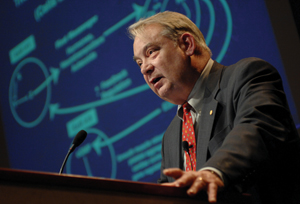
Nobel Laureate Ferid Murad, M.D., Ph.D., spoke on his research into cell communication and signaling and the role of intracellular messenger molecules during his recent Discovery Lecture. (photo by Dana Johnson)
Lecturer recounts discovery of gaseous signal molecule

Ferid Murad, M.D., Ph.D., the featured scientist at last week's Discovery Lecture, said he found it fitting that he was speaking on Valentine's Day.
“Much of what I'll talk about this afternoon is related to cardiovascular problems and cardiovascular biology,” he said.
He then traced his 40-plus years of research dedicated to the broad areas of cell communication and signaling, and the role of intracellular messenger molecules.
Murad, the Regental Professor in the Department of Integrative Biology and Pharmacology at the University of Texas, Houston, shared the 1998 Nobel Prize in Physiology or Medicine for his research on nitric oxide as a signaling molecule in the cardiovascular system. He and his two Nobel co-recipients discovered how the colorless gas can signal blood vessels to relax and widen, thus lowering blood pressure.
During last week's lecture, which was the fourth annual Grant R. Wilkinson Distinguished Lectureship in Clinical Pharmacology, Murad recounted how he and colleagues discovered that nitroglycerin, a long-used treatment for angina and heart disease, works by releasing the gaseous signaling molecule nitric oxide.
The possibility that a short-lived gas like nitric oxide could serve as a physiological signal was initially met with skepticism in the scientific community, he said.
“People thought I was crazy.”
But it was ultimately realized that nitric oxide derived from drugs like nitroglycerin mimics nitric oxide that is produced naturally in almost every tissue in the body.
In the 30 years since the first report appeared about nitric oxide as a signaling molecule, more than 90,000 papers about nitric oxide and its various roles have been published, Murad said.
“The field has been remarkable,” he said. “It's been exciting to be involved.”
Nitric oxide is now known to participate in a laundry list of processes and diseases including vasodilation, neurotransmission, glaucoma, inflammation, gene regulation and even stem cell proliferation and differentiation, an area that Murad and his colleagues have begun to explore.
The broad range of biological processes in which nitric oxide plays a role offers both opportunities and challenges for drug development, Murad said.
In addition to mediating useful signaling, nitric oxide can be hurtful. It is a free radical — a highly reactive molecule that can attack and damage cellular proteins, fats and DNA.
“There's no other molecule in the body quite like it,” Murad said.
For a complete schedule of the Discovery Lecture Series and archived video of previous lectures, go to www.mc.vanderbilt.edu/discoveryseries.













